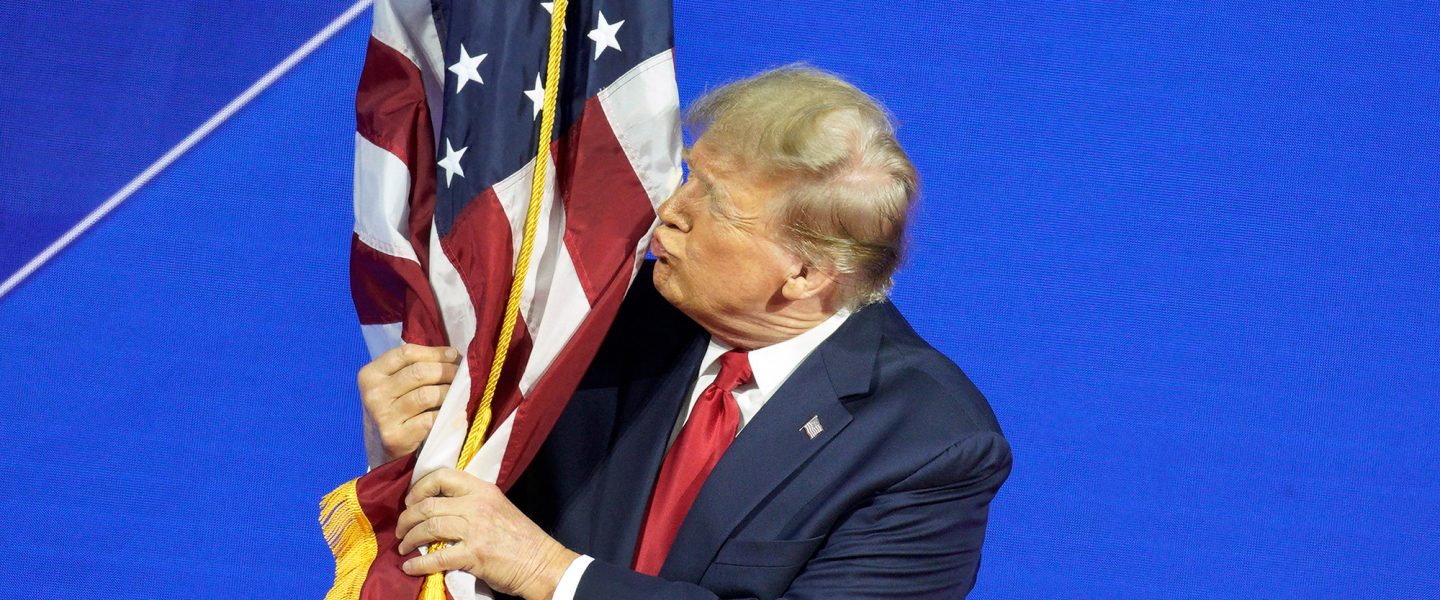Donald Trump and the Dictator’s Doom Loop
Whether or not Trump is a psychopath, I leave to the medical profession; I am simply describing a clear pattern of behavior.
|
Listen To This Story
|
It emerged this past week that Donald Trump’s legal strategy to avoid facing any federal trial before the 2024 election — after which, if he wins, he can simply have his DOJ dismiss all federal charges against him — was to make use of Judge Aileen Cannon, whom he appointed, to “ice” (i.e., block) Judge Tanya Chutkan, whom he did not.
The way the scheme was supposed to work is this: First, get Cannon to push Trump’s “documents” trial in Florida back to July, after keeping it on her calendar for May, where it currently sits, until the last possible minute.
That was intended to, first, clog up the spring calendar, keeping a spring trial on the “insurrection” case off-limits to Chutkan (everyone agrees Trump’s trials can’t overlap). Then, by moving the documents trial to July, block a summer trial of the insurrection case.
Meanwhile, the idea was to keep delaying the insurrection trial to preclude any possibility of holding it before July. And finally, once that was accomplished and July rolled around, then get Cannon to delay her trial even further such that it would be too close to the election for it to go forward.
That devious plan to run out the clock — complex as it is cynical — just got a whole lot simpler with the Supreme Court’s surprising decision to accept Trump’s appeal of his DC Circuit Court of Appeals-rejected Hail Mary “immunity” claim.
As Harvard legal scholar Laurence Tribe put it, commenting on SCOTUS’s course of action: “It’s not the way a country that is concerned to preserve the rule of law and constitutional democracy would proceed.”
For those keeping score at home, recall that special counsel Jack Smith first asked SCOTUS to rule on Trump’s Chutkan-trial presidential immunity appeal back in early December. The court declined to do so in spite of the fact that, as we now know, at least the necessary four justices were willing to take the case eventually. Having just done so, and with “all deliberate speed,” SCOTUS — which somehow managed to decide the more complicated case of Bush v. Gore in all of four days — scheduled oral argument for the week of April 22.
The total delay comes to a minimum of 130 days, or just about half the period in which the trial was considered viable.
Few court-watchers believed that even a right-dominated SCOTUS would accept Trump’s half-baked and dangerous blanket immunity appeal. The unanimous opinion by the three-judge DC circuit panel, which was headed by a George H.W. Bush appointee, laid out with utmost clarity both the dangers and absurdities of Trump’s claim.
As Harvard legal scholar Laurence Tribe put it, commenting on SCOTUS’s course of action: “It’s not the way a country that is concerned to preserve the rule of law and constitutional democracy would proceed.”
Now, thanks to Trump’s friends in that highest of places, there is no longer any need to box Chutkan out of a spring trial date. A SCOTUS disposition of Trump’s immunity appeal would likely not come before midsummer at the earliest. And there is the further danger that SCOTUS may well remand to the trial court with instructions to sort out the implications of some partial immunities, which will mean more pre-trial festivities and yet more time off the clock.
Chutkan, for her part, tried her best to move forward expeditiously: Before Team Trump tied up the works with his immunity claim, the insurrection trial was on her calendar for March. Cannon, on the other hand, has thus far served as a willing power tool in Trump’s delay game.

The Whole Ballgame
So, between a sympathetic SCOTUS in DC and a compliant trial judge in Florida, it is not hard to imagine things playing out exactly as Team Trump has drawn them up: With Chutkan “iced” and Cannon slow-walking, there will be no federal criminal trial before America votes.
If that is in fact the case when the dust settles, the jig will be up for justice, and America’s voters — nearly two-thirds of whom, including nearly 4 in 10 Republicans, have indicated they want to see a verdict in at least the insurrection trial before voting in November — will be left in the dark.
This is pretty much the whole ballgame, as polls have made clear that Trump’s currently rosy chances of victory would plunge following a criminal conviction.
There are still, to be sure, the two state trials. But the hot mess that District Attorney Fani Willis has made of the election interference case in a Georgia state court has virtually no chance of proceeding to trial before the election.
And the New York State “hush money” case, which is going to trial in March, is regarded by Trump as nothing more than a potential electoral flesh wound, a mere peccadillo carrying little risk of jail time — at worst a “conviction” with an asterisk.
So Trump will have pulled every possible lever of a stacked federal judiciary (thank you, Mitch McConnell). And, although there is a slight risk of a federal trial actually taking place in the run-up to the election, it seems more likely than not that Trump will escape federal criminal accountability — and, with it, electoral accountability.
And then, having fist pumped his way back into the White House, he can shut it all down.
There is something so wrong with this picture that it defies description. It fills me with what I have come to recognize as the single most excruciating emotion I can experience: impotent rage.
It also scares the daylights out of me. Here’s why.
The Dictator’s Doom Loop
My alarm stems from recognition of a historical pattern I call the Dictator’s Doom Loop. In the case of Trump, I’m talking about something much darker than his use of the D-word, most notably in the infamous whack he took at Sean Hannity’s softball, “You’re promising America tonight, you would never abuse power as retribution against anybody.”
Trump: “Except for Day 1. … After that I’m not a dictator.”
For many anxious listeners, that teasing interruption came across as a plan to be a dictator from day one, which was not exactly what Trump said. Let the record show that he responded to Hannity, and has repeated since, that he would not be a dictator “except for Day 1.”
But you could comb the history books for many a year and find no example of a one-day dictator. And not a lot of one-week, one-month, or even one-year dictators — dictators who decided on their own hook to stop being dictators.
Which brings me back to our Dictator’s Doom Loop after all. The pattern is, like all doom loops, an inexorable positive-feedback cycle, in which dictatorial behavior triggers the kind of resistance that necessitates even more dictatorial behavior, harsher repressions, and deadlier measures.
The loop is something of a historical staple, from the quasi-historical Macbeth, through Hitler, Stalin, and Mussolini, to the contemporary Bashar al-Assad, with many more between. It is likely to be somewhat mitigated or deferred when strongmen take power with the assent and adulation of the bulk of their populace — though even such “beloved” dictators generally wear out their welcome, a la Nicaragua’s Daniel Ortega, and head down the doom loop path.
Donald Trump would not take power in 2025 with the assent and adulation of the bulk of the populace.
In the minds of something like half of America (and, for what it’s worth, most of the world) he will be a serial felon and coup plotter who managed to game the justice system to evade accountability and escape judgment.

As if that were not enough, he will take office with an unbending will to forcefully impose grossly unpopular policies without compromise or accommodation. He will bring with him a small army of thoroughly vetted ultra-MAGA hyper-loyalists to clear-cut his path through the thicket of democracy and facilitate the revenge and retribution he has repeatedly signaled will be high on his list of priorities.
And he will, if history and his own previous efforts are any guide, be itching to invoke the Insurrection Act. But what frightens me most is that, even were he not so inclined, it is unlikely that he will have much choice.
Should he take office having danced through his legal minefield and denied the voters the chance to know whether they were voting for (or against) a felon convicted of the most serious of “political” crimes, I surely won’t be the only one seething with rage.
Trump as president under such circumstances would be hated — and I mean hated — and feared by many millions.
There would be no honeymoon. He would be President Pariah on Day 1.
There would be resistance; there would be protests; there would be a torrent of harsh words and, almost certainly, deeds.
From the very start, Trump would have to, figuratively and quite possibly literally, take arms against this sea of troubles and raging throng of enemies. It isn’t hard to picture, roughly at least, what that would look like. As he imposes his policies — whether drilling or wall-building or defunding Ukraine or withdrawing from NATO or banning abortions or mass incarcerations and deportations — the a priori rage that greeted his ascension will even further intensify. Fierce criticisms will be written and spoken and chanted, implacable resistance encountered on every front.
Some have speculated that Trump would content himself with the White House as his safe house, scuttling the trials and just getting back to his grift. There is little to indicate, however, that such a course — and the relative equilibrium it might bring — would, or could, be his choice.
All the more so if he follows through on his threats of revenge and retribution. I ask myself: If he targets for such treatment even one fellow journalist, or Gen. Mark Milley, or former Reps. Liz Cheney and Adam Kinzinger, or any of the courageous among us who have dared to speak against him or cross him in some way or who simply refuse to bend the knee and kiss his ring, would I stand helplessly by? Would their friends and colleagues? Would you?
A Frightful Choice
Please forgive the dark and stormy crystal ball but I hope it’s clear where this is going. When leaders do unconscionable things, the people — in this case “We the People” — under that leader’s sway, or thumb, face a stark choice: resist or acquiesce, rise up or stand by.
If even a small number — sickened by Trump’s evasion of both justice and political consequence, unable to stomach the destruction of both individuals and democracy inherent in his “Project 2025” consolidation and projection of power — choose to resist, history foretells that Trump will forthwith enter the Dictator’s Doom Loop.
Moving against the resistance, with either hard (think Lafayette Square or Tiananmen Square) or soft (think the prosecution of the late Alexei Navalny) power, would re-pose the same question — resist or acquiesce, rise up or stand by? — in a still higher, more urgent pitch.
More resistance engenders ever more brutal dictatorial measures to quell it, which then in turn engender still angrier and more desperate resistance, in an ever-escalating cycle culminating in a final crushing or a full-scale revolt and civil war. The taller a democracy has stood — the further it has to fall — the harder and more cataclysmic that fall bodes to be.
Some have speculated that Trump would content himself with the White House as his safe house, scuttling the trials and just getting back to his grift. There is little to indicate, however, that such a course — and the relative equilibrium it might bring — would, or could, be his choice.
He has already shown himself to be someone whose needs are unbounded and bottomless, who must have — especially in his years of decline and face to face with his mortality — essentially infinite approval and acclaim. Someone, to put it plainly, who must be worshiped. And who must smite those who refuse to do so.
Whether or not Trump is psychotic or a psychopath I leave to the medical profession; I am simply describing a clear pattern of behavior. Power in the hands of such a person is beyond dangerous — it is apt to be explosive.
Speaking alongside Trump last week at CPAC, far-right, cross-waving acolyte Jack Posobiec delivered this chilling message:
Welcome to the end of democracy. We are here to overthrow it completely. We didn’t get all the way there on January 6, but we will endeavor to get rid of it.
If Trump makes good on his veiled and not-so-veiled threats to move on democracy — if he, having been elected with the essential aid of a Supreme Court in which his appointees hold sway, commences to tear down the remains of a republic we just a short while ago believed to be vibrant and enduring — what will we, the displaced, do?
Will we shore up the ruins of our birthright? Will we rebuild? Will we abandon hope?
Resist or acquiesce? Rise up or stand by?
History and the present world are full of examples of nations whose people have concluded that resistance is futile or democracy not worth the price, keeping their heads down and going about their daily lives with their eyes averted. America could soon be such a place.
Jonathan D. Simon is a senior editor at WhoWhatWhy and author of CODE RED: Computerized Elections and the War on American Democracy.


